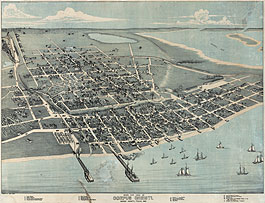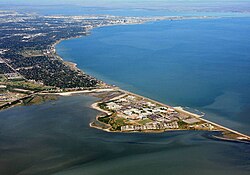
USS Brooklyn was a sloop-of-war authorized by the U.S. Congress and commissioned in 1859. Brooklyn was active in Caribbean operations until the start of the American Civil War at which time she became an active participant in the Union blockade of the Confederate States of America.
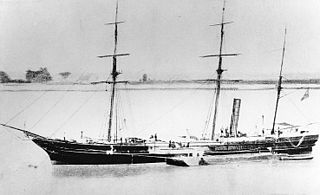
CSS McRae was a Confederate gunboat that saw service during the American Civil War. Displacing around 680 tons, she was armed with one 9-inch (229 mm) smoothbore and six 32-pounder (15 kg) smoothbore cannon.
USS New London was a screw steamer of the Union Navy during the American Civil War. She was outfitted with a Parrott rifle and 32-pounders, and was assigned as a gunboat in the Union blockade of the Confederate States of America.

The second USS Metacomet was a wooden sidewheel steamer in the United States Navy during the American Civil War. The ship was named for Metacomet, a war chief of the Wampanoag Indians.
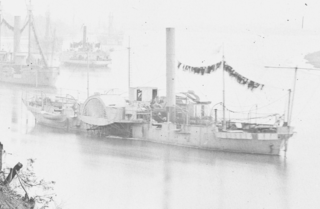
The first USS Miami was a side-wheel steamer, double-ender gunboat in the United States Navy during the American Civil War.

The first USS Seminole was a steam sloop-of-war in the United States Navy during the American Civil War.

The Battle of Elizabeth City of the American Civil War was fought in the immediate aftermath of the Battle of Roanoke Island. It took place on 10 February 1862, on the Pasquotank River near Elizabeth City, North Carolina. The participants were vessels of the U.S. Navy's North Atlantic Blockading Squadron, opposed by vessels of the Confederate Navy's Mosquito Fleet; the latter were supported by a shore-based battery of four guns at Cobb's Point, near the southeastern border of the town. The battle was a part of the campaign in North Carolina that was led by Major General Ambrose E. Burnside and known as the Burnside Expedition. The result was a Union victory, with Elizabeth City and its nearby waters in their possession, and the Confederate fleet captured, sunk, or dispersed.
The second Navy vessel to bear the name Sachem, this screw steamer was built in 1844 at New York City, where it was purchased by the Navy on 20 September 1861.
USS William G. Anderson was a barque used by the Union Navy during the American Civil War. She was assigned by the Navy to patrol navigable waterways of the Confederacy to prevent the South from trading with other countries.

USS Calhoun was a captured Confederate steamer and blockade runner acquired by the Union Navy from the prize court during the American Civil War.
USS Corypheus was a schooner captured by the Union Navy during the American Civil War.
USS Belle Italia was a sloop captured by the Union Navy during the American Civil War. She was used by the Union Navy as a gunboat in support of the Union Navy blockade of Confederate waterways.
USS Arthur was a bark acquired by the Union Navy during the American Civil War. She was used by the Union Navy as a gunboat in support of the Union Navy blockade of Confederate waterways.
USS Breaker was a schooner captured by the Union Navy during the American Civil War. She was used by the Union Navy as a gunboat in support of the Union Navy blockade of Confederate waterways.
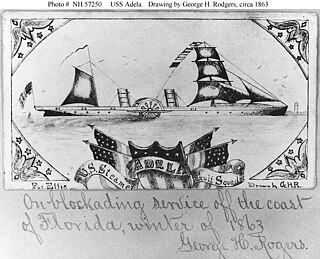
USS Adela was a steamer captured by the Union Navy during the American Civil War. She was used by the Union Navy as a gunboat in support of the Union Navy blockade of Confederate waterways.

The Bahia incident was a naval skirmish fought in late 1864 during the American Civil War. A Confederate navy warship was captured by a Union warship in the Port of Salvador, Bahia, Brazil. The engagement resulted in a United States victory, but also sparked an incident between the United States and Brazil, over the American violation of Brazil's neutrality by illegally attacking a vessel in a Brazilian harbor.

The action off Galveston Light was a short naval battle fought during the American Civil War in January 1863. Confederate raider CSS Alabama encountered and sank the United States Navy steamer USS Hatteras off Galveston Lighthouse in Texas.
The Texas Marine Department (1861–1865) was formed in the State of Texas shortly after Texas came under blockade from the Union Navy in 1861. It operated under the control of the Confederate Army during the Civil War.
